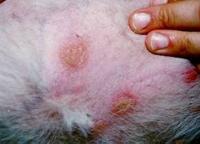Itchy Dogs and Cats
Many things can cause itchy dogs and cats. Discovering the cause of the dog or cat scratching can help you treat it appropriately. This gives you the best chance to get rid of the problem completely or to know how to control it.
There are a few clues that can help you narrow down the possibilities. You can then treat your pet based on what you observe. If your pet doesn’t get better, then you will need to visit your vet.
Age
The age at which the itchiness starts can sometimes help. Parasites, infections, and food allergies can start at any age. Other causes are more likely to start at certain ages.
- Parasites, infections, and food allergies are the only things likely to cause dog or cat scratching if your pet is younger than 6 months of age.
- From 6 months of age until about 4 or 5 years, the cause is often allergies to things in their environment.
- Older than 5 or 6 years of age, it’s unlikely to be environmental allergies in itchy dogs, though it can still be a food allergy. Cats can still develop environmental allergies. It is more likely to be related to a hormone problem or skin cancer.
Location
Where on the body the itchiness first started may provide another clue. Certain conditions tend to cause your pet to scratch in certain areas. It’s important to note where the itchiness first started as it can change over time.
- Itchy dogs that are scratching just the back one third to one-half of the body usually have a dog flea allergy. This is not the case with cats. With cat flea allergies you may see cat allergy symptoms such as licking and scratching anywhere
- Problems along the edges of the ears, elbows, and hocks may be due to scabies (also called sarcoptic mange). A mite causes this and it is usually very itchy. This mite is usually in dogs and is rare in cats. It can also affect people
- Dog and Cat Allergy Symptoms: Dogs with environmental allergies often are itchy on the face, feet, ears, or belly. Cats can be itchy anywhere
How the Skin Looks, Feels, and Smells
These signs aren’t as specific as the other ones, but may help.
- An oily feel to your pet’s coat often indicates seborrhea. Seborrhea is a disorder of the oil glands in your pet’s skin. It can cause excessive dryness or oiliness. Seborrhea becomes itchy when an infection is part of the problem. These pets usually have a smelly coat as well. The excess oil becomes rancid, thus generating odor
- A greasy, smelly coat can also be due to a yeast infection. It may have a musty or yeasty smell to it
- You can see red bumps and crusty circular spots often with hair loss from bacterial or fungal infections (you may see your dog or cat licking these areas)
Other Considerations for Dog and Cat Scratching
- If your pet also has gastro-intestinal signs such as vomiting or diarrhea, which can be intermittent, than a food allergy is more likely
- If several pets in the house or people also have problems, it’s more likely a parasite or ringworm. The common bacterial and yeast infections pets get don’t spread to other pets or people
- If the itchy dog or cat scratching signs are a problem at certain times of the year, it is usually an environmental allergy
These clues may help you narrow down the possible causes. However, often there are combinations of causes at play.
Bacterial and yeast infections are often present on top of something else. A common scenario can be found in a pet with allergies who is scratching. The scratching damages the skin and the bacteria or yeast causes an infection.
Treatment
The first thing to do for itchy dogs or cats is to treat for fleas whether you see them or not. Flea allergy is the number one cause of skin disease.
If you don’t make sure fleas are a part of the problem, you may never help cure your pet.
The next thing you often need to do is to treat and control bacterial and yeast infections. When these are present, they will add to the itchiness. Until you get rid of them, you can’t tell what else might be going on. In mild cases, topical treatments can clear up the infection.
Shampoos are your best friend! You can help many skin conditions with bathing. The drawback is that some pets aren’t cooperative and bathing can be labor intensive. You usually need to do it every 2-3 days at the beginning. However, it’s something you can do it at home and it can make a big difference. Medicated shampoos can treat bacterial and yeast infections and improve seborrhea, as well as helping with dog and cat allergy symptoms like itchiness. Trimming long hair makes bathing easier.
There are also medications you can give that may help reduce the itchiness.
Summary
Discovering what is causing your pet to scratch helps you decide the best way to help your pet. Unfortunately, figuring it out isn’t always easy and often there are multiple things going on. Looking at some of the clues (like dog or cat scratching or dog or cat licking themselves excessivley) may help though!
Keep in mind these are just general guidelines as many skin conditions can look similar. In addition, some pets don’t go by the book and behave differently!
You can try treat your pet at home to see if he gets better and becomes more comfortable. However, don’t wait too long if your pet doesn’t improve or seems to be getting worse. If an infection is present, the earlier it’s treated, the easier it is.
Your vet can also run some tests to help determine what is going on. Some conditions will need specific medication to treat them. Lastly, if your pet isn’t feeling well, isn’t eating well, or his skin is visably unhealthy, see your vet immediately.
All articles are reviewed and maintained by whiskerDocs team of veterinary experts.





